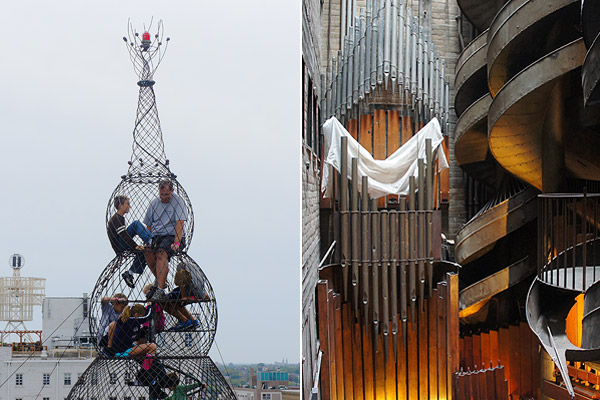
This weekend I went to St. Louis to experience two family-friendly temples of merriment. The first was Busch Stadium, home of my favorite sports team. I've long contended that the Cardinals are the quietly reasonable team you should be rooting for, pitched between the A's and Rays (scrappy, sabermetrically efficient teams that play in terrible stadiums with no fans) and the Red Sox and Yankees (overexposed economic titans with overbearing fanbases). Busch and its attendeeds did not fail to disappoint: a sea of red sans boozy yelling and screeching PA systems. Speaking of which, one theory for why attendance is low at the Cell: the keening, always-active audio-distraction system. If I wanted to be immersed in loud snippets of popular song, I'd stay at home and play a scratched Van Halen record over the Hawk.
The other was the City Museum. The name makes it sound like a generic monument to the Gateway to the West, but it's actually a wild, singular vision of an oddball artistic mind; the only thing I've ever seen like it is the Museum of Jurassic Technology in Los Angeles, made famous by Lawrence Weschler's Mr. Wilson's Cabinet of Wonder. But where the MJT is grownup, mysterious, and arch, the City Museum is like something conceived by a child with an arc welder and access to an unlimited amount of scrap metal.
The outside of the building features a vertigo-inducing jungle gym of open steel tubes, slides, and spiral staircases, connecting two gutted planes, a treehouse, a fire truck, and a castle (the last of which was closed). Inside, there's a ten-story spiral slide—of course I went down it—caves, all sorts of random water features, a store that makes shoelaces using vintage equipment, a candy store, a bar (inside a log cabin once home to the son of Daniel Boone), a pipe organ, and yet more slides and vertical passageways, many of which are too small for anyone but a kid to enter. Not to mention the acquarium, which has not just stingrays and sharks but cockroaches and scorpions. On the roof, there's a pond, more slides and climbs—and a ferris wheel.
It's remarkable that it exists, and it took the oddball mind of Bob Cassilly, a sculptor, developer, and building contractor's son, to make it happen; climbing around, you can see how it's a totally bent imagining of construction and habitation. Cassilly's next project was called Cementland, and it was there that Cassilly, who often worked independently and without permits, was killed when his bulldozer flipped over late last year. It's more remarkable yet because it looks like not just the singular vision of one man, but like the work of one as well. There are rough edges and dimly lit corners where other things remotely like it are bright and smooth, metal where you'd expect plastic and glass, gaps where you wouldn't expect them, for better or worse. And it's been the subject of numerous personal-injury lawsuits, which led to some hostility from Cassilly towards the legal system. It's impossible to imagine something like it in Chicago, but it's not too far away.



